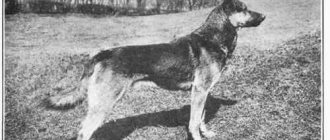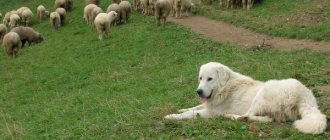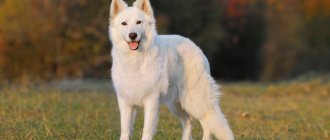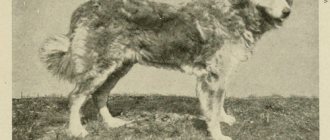Video
* We invite you to watch a video about the German Shepherd . In fact, in front of you is a playlist in which you can select and watch any of 20 videos about a given dog breed by simply clicking on the button in the upper right corner of the window. In addition, the material contains quite a lot of photos. By looking at them you can find out what a German Shepherd looks like.
In this article:
|
Rate the material!
[Total votes: 5 Average: 5]
The nobility of the German Shepherd is noticeable from afar; its stately figure and beauty delight. It is not for nothing that dogs of this particular breed become frequent heroes of various films and TV series. Let's try to figure out how to properly keep such a large pet at home, what kind of character a German shepherd , what character traits are inherent in it, and what it doesn't mind snacking on.
History of the breed and its origin
Two main centers of origin are identified, namely in the current territory of Scandinavia and North-Western Russia, but even here there was an admixture of Indian wolf blood. The first representative of the German Shepherd as a breed, the off-white color Greif, was shown at an exhibition in Hanover in 1882. Greif was the first to be included in the pedigree book of German Shepherds.
The German Shepherd was developed at the end of the 19th century. The breed owes its official birth to the efforts of the founders of the German Shepherd Lovers Club, headed by Captain Max von Stefanitz, who is rightfully considered the spiritual father of this dog breed. Von Stephanitz's open-mindedness allowed him to evaluate different types of German Shepherds without any bias in the hope of creating some kind of average type. The future breed was based on one single principle: “A German Shepherd is considered to be any herding dog living in Germany, which, thanks to constant training of its qualities as a shepherd dog, achieves physical and mental perfection within the framework of its utilitarian function.”
The breeding of the breed, organized and carried out on a national scale, progressed rapidly thanks to the combined efforts of German herding dog breeders. In 1899, the German Shepherd was officially shown at a dog show for the first time.
History of the origin of German Shepherds
Archaeological scientists have found that the ancient ancestors of German shepherds inhabited the Western European expanses about four thousand years ago. Canine remains similar in parameters to the ancient small Indian wolf were found in Austria. Scientists believe that these wolves are the ancestors of shepherd dogs, which were most common in the Middle Ages, and the familiar German shepherds take their origin from them.
The name of the breed suggests that the dogs guarded sheep flocks, and the adjective “German” was added to it due to the fact that in the 18th century Germany became the center for breeding dogs of this breed. Dogs gained widespread popularity at the turn of the 16th century. At a time when not only ordinary people, but also nobles appreciated their security functions. In the documentation of that time, it was recorded that shepherd dogs are able to protect not only the person (the owner), but also his things, belongings (property).
In Germany in the 18th century, two types of shepherd dogs were bred, which differed:
- Large build - had red or black long hair, drooping ears and a rather gentle disposition;
- They had a medium build - more active, aggressive and had a coloring similar to that of a wolf.
In the 19th century, the crossing of “Germans” and shepherd dogs began to gain momentum, so more and more different types of German shepherds appeared. People tried to breed a non-aggressive dog with excellent guard qualities and excellent controllability.
As for our country, this breed began to be bred here just one century ago. The first time German shepherds were brought to Russia was as ambulance dogs that took part in the Russo-Japanese War. Several canine specimens became employees of police departments in St. Petersburg. At the end of the revolution, even more dogs were needed for service, so shepherd dogs were imported from Germany in large quantities.
Interesting fact: There is evidence that during the Great Patriotic War, 60,000 four-legged soldiers served in the army.
Shepherd dogs successfully served in various troops:
- Sapper;
- Sabotage;
- Intelligence.
German dog breeds
German dog breeds are the most common group in the world if you classify animals by country of origin. The motley group of pets is a unique reflection of the rich history and unique culture of Germany. Owners highly value German breeds for their inherent characteristics: poise, endurance, vigilance, devotion, intelligence, self-esteem. Typically, dogs have a lean, muscular build, smooth, shiny coat and a pointed muzzle. Among the “Germans” there are excellent guards, watchmen, hunters and companions, as well as pets capable of combining these functions. The list from Lapkins.ru presents German dog breeds with names and photographs. The selection includes both popular and quite rare animals.
The most famous breed from Germany is the German Shepherd. The dogs are friendly, loyal and highly intelligent, ranking among the top 3 smartest breeds in the world. German shepherds have repeatedly become heroes of TV series, such as “Commissioner Rex” and “The Return of Mukhtar.” In real life, dogs also performed flawlessly both in service and as best friends. Just look at the value of a German shepherd named Palma, who was abandoned at Vnukovo airport and met planes for several years in the hope that the owner would return!
In addition to the shepherd, there are many other large breeds among German dogs: boxer, Great Dane, Doberman, Rottweiler, Giant Schnauzer, Leonberger. The famous pointers - shorthaired pointer, drathaar, langhaar and Weimaraner - also come from Germany. The German Pinscher, although medium in size, can boast that it was bred back in the 18th century and became the progenitor of a number of breeds. The Bavarian mountain hound appeared in the 20th century and immediately established itself as an active dog that always catches shot game.
Among small, fluffy “Germans,” Pomeranians are in high demand. Charming pets were originally a privilege of the aristocracy and, using their ringing voice, drove birds away from the vineyards. Gradually, the charming beauties moved to the owner's sofas and turned into delicate companions, delighting their owners with various tricks. Take a closer look at the equally charming miniature breeds: German Jagdterrier, Dachshund, Affenpinscher, Miniature Pinscher and Miniature Schnauzer.
German Shepherd - description of the breed
The German Shepherd is a fairly large dog, but it cannot be called gigantic. Almost all subtypes of this breed are characterized by thick hair with dense undercoat, a powerful chest and a recognizable dog-like stance, in which the naked eye can see that the animal’s pelvis is clearly low. The standard weight of dogs varies from 25 to 40 kg, and the height at the withers ranges from 55 to 65 cm. The predominant color of this dog breed can be called saddleback, it is a classic for the “Germans” and is characterized by a combination of black wool with some tan.
Dog experts say that German Shepherds are highly intelligent dogs with self-control and calmness. Of course, young German Shepherd puppies can be eccentric rebels, but all these headstrong tendencies can be curbed with the help of competent training. It is these amazing dogs that are highly appreciated by law enforcement agencies of various countries, where four-legged guards perform honest and faithful service. It has long been proven that they act as first-class watchmen, skilled detectives of various prohibited and explosive substances.
When puppies are only a few weeks old, they can already be trained, listening to the commands and prohibitions of the owner. It is not for nothing that there is an opinion among dog handlers that these dogs are among the smartest among other breeds. German Shepherds have excellent contact with children, becoming their true friends, which speaks of their good-natured and non-conflict disposition. These noble canines live from 10 to 14 years.
Breed standard
German Shepherd Puppy The
German Shepherd breed standard was first compiled by Stefanitz and Mayer in 1899. The original text was amended at the 6th Assembly of SV
, which took place on July 28, 1901, at the 23rd Assembly held on September 17, 1909 in Cologne, at the meeting of the Board of Directors and Advisory Committee in Wiesbaden on September 5, 1930, and at the meeting of the Breeding Commission and the Board of Directors on March 25, 1961.
The text was then revised by the World Union of German Shepherd Societies and adopted at the WUSV
on August 30, 1976. Once again the standard was rewritten and restructured on March 24, 1991.
Popular colors of German Shepherds
We are used to seeing German Shepherds with a black tint in the muzzle area, and a reddish color on the back and underside. In fact, experts distinguish three types of suit, which are considered the norm. Of course, there are other colors, but they are considered non-standard and mean a defect; such dogs are no longer accepted for participation in exhibitions, but they can happily become ordinary pets.
Standard colors include dogs of the following colors:
- Black Sheepdog;
- Black Shepherd;
- Zone Shepherd.
Black color is considered the most common; 90 percent of dogs of this breed have it. It is distinguished by the presence of a black spot on the ridge, shaped like the letter “V”. The dark tone is noticeable on the sides, top of the tail, and may be visible on the elbows. The lower part of the body has a light tone, which extends to the belly, chest, neck, and paws.
This dog color allows the presence of such shades as fawn (yellowish), brown (chocolate), gray. A prerequisite is the presence of a black mask covering the muzzle and ear area. If no mask is observed, then this is considered a defect, and the darkest shade of tan is considered the most preferred shade.
The zone color is the rarest, found in only 5 percent of shepherd dogs. This coloring is formed due to the different colors of different parts of the coat. At the base it has a light shade, in the middle part it becomes dark, then turns yellow, and at the tips it is black.
Zonal coloring is also called:
- Gray;
- Agouti;
- Wolf;
- Gray-haired.
The greatest intensity of the color scheme of this color can be seen on the face, ridge and tail; it becomes more faded on the sides and in the paw area. Any shades are allowed here - from chocolate brown to pale yellow. The main thing is that the sequence (structure) of coloring is not disturbed.
Only 3 to 5 percent of “Germans” are considered rare owners of the noble black color. It is not difficult to guess that their elegant coat is jet black. Any tiny inclusions of other shades, whitish spots and marks act as deviations. Even the dog's nose and claws should be dark. In all-black German Shepherds, the coat color remains the same even when shedding occurs.
Another color stands out - black and tan, which many experts do not consider independent, but argue that it acts as a cross between three standard types of colors. The predominant shade of such a dog is black, only in the belly area are reddish-brown inclusions noticeable; they can also be on the inside of the paws. Light cheekbones, eyebrows and chest are acceptable. The black and tan coloring may become lighter as the dog gets older and weaker from litter to litter.
There are other colors of the German Shepherd, which are considered rare and non-standard (defective).
These include:
- White;
- Gray-blue;
- Yellow-red;
- Spotted;
- Golden;
- Roan.
Dogs of this color are not allowed into exhibitions, but as pets, they are no worse than standard ones, and much more original.
Origin of the breed
The German Shepherd began to develop as an independent breed of dog a long time ago, back in the Bronze Age. Its ancestor was the small Indian wolf, although scientists prove that the animal came from a wolf and a common dog. The ancestors of the modern individual were Hofowarts - dogs that in the Middle Ages guarded houses and herded herds. It was from the fact that they were constantly with the flocks that the modern name of the breed was obtained.
The description of the German Shepherd breed was mentioned already in the seventh century in the code of laws, and already in the sixteenth century powerful and courageous guards acted under this name. Shepherd dogs began to be cultivated in the German districts of Württemberg and Thuringia. In the nineteenth century, the population grew as different types of herding dogs from different regions of the country were actively crossed.
In 1891, the Phylax society of lovers of these proud and faithful animals was created, whose creator, Count Gan, established the first breed standard. Today it is the most influential club of cynologists of a specific breed, which has its own status and actively organizes exhibitions. At the same time, a pedigree is issued, which can only be obtained by a German Shepherd whose breed characteristics are ideal.
Character and habits of German Shepherds
Many experts and dog experts believe that the “German” is simply ideal in character and can only be praised and praised. These dogs are distinguished by incredible nobility and loyalty. They do not tolerate laziness and are always happy to spend time usefully, satisfying their owner. You will not see aggression in a dog’s eyes; four-legged animals do not like to conflict, both with people and with other representatives of the fauna. Their reaction to any situation is always adequate and most rational. Feeling that something or someone is threatening the owner, the shepherd will not wait for commands, but will react with lightning speed in order to protect.
Interesting fact: German Shepherds are incredibly brave, selfless and fearless. They will not compare their strengths with those of an ill-wisher; the dog will not hesitate to enter into a fight if danger threatens its beloved owner.
“Germans” are strongly attached to their owners, but they also treat other family members with respect and love. They behave with children at ease, cheerfully and carelessly, indulging in their fun and games. Shepherds remain wary around strangers, but do not allow aggression unless the situation requires it. Shepherds are friendly towards other pets, without feeling jealousy or envy, and can even develop friendly relations with them.
These well-mannered and graceful dogs do not like loneliness and get very bored if the owner is absent for a long time. They can be protected from melancholy by giving a responsible assignment (for example, to guard something), then the dog will get down to business and try to vigilantly complete the assigned task. Experts assure that shepherds have a stable psyche, nerves of steel, and a balanced and non-conflict character.
These dogs are called not only intellectuals, because they are unusually smart and extremely smart, but also real intellectuals, because... one can envy their upbringing and self-control. You won’t find cowardice and indifference in the “Germans,” but there is as much courage, dexterity, loyalty, insight, hard work and nobility as you want!
Pros and cons of the breed
A character description can highlight the positive and negative aspects of a breed such as the German Shepherd simply perfectly. The advantages of the breed include:
- high intelligence, which allows you to quickly train, are able to do what other breeds cannot;
- Shepherd dogs, especially females, have strong mental balance, therefore they do not conflict with either people or cats;
- they love children with whom they can play for a long time, and they will not show aggression towards an annoying baby;
- the ability to get along with people and lack of vindictiveness, even if the owner offended the pet;
- unpretentiousness to living conditions, including in military field conditions, and the animal is able to instantly adapt to a change in situation;
- dedication, since the pet is capable of protecting the owner and members of his family even at the cost of his life, although he is not a fighting dog.
The peculiarity of dogs of this breed is that they protect the owner, emphasizing that he is only her, and being jealous of other animals or people.
The disadvantages include increased activity, since you will have to spend 2 or more hours walking. Purebred dogs are distrustful of strangers, have an increased appetite, and as they grow older they gnaw and bite everyone around them.
The animal will require proper upbringing, and sometimes you will have to spend money on special training courses. This is done in order to suppress outbursts of aggressiveness. Only proper training will help combat the problem, since buying a muzzle will not solve anything.
Interesting facts about German Shepherds
We can talk about German Shepherds for hours, because... this breed is very common, loved by many and brings benefits to society. Let's try to tell the most interesting and fascinating things about this canine nature, citing a number of interesting facts.
The first representatives of German shepherds to participate in the exhibition in 1882 were dogs - Kiras and Greif; they had a light gray color, which these days is considered a defect. Dogs of this color are currently not allowed for exhibitions. Experts consider the German Shepherd the most suitable for a variety of work activities.
German Shepherds are highly intelligent dogs. In 2013, the American Kennel Club ranked them as one of the three smartest breeds, possessing lightning-fast intelligence in extreme situations. The powerful jaws of the German Shepherd have a pressure force exceeding 100 kilograms.
During the world wars, these dogs were the bravest and fastest orderlies, bringing medicines in bags and helping to carry out the wounded from the battlefields. German shepherds and their handlers took part in the very first Victory Parade. And the hero-dog Dzhulbars, who had not yet recovered from his injury, was carried by dog handler Mazover. The dog detected 150 shells and 468 mines. They say that Mazower carried him across the square on Stalin's greatcoat.
The zonal color gene in “Germans” is considered dominant. Surprisingly, it is impossible to breed puppies of this color by crossing a pair of zoned shepherd dogs - the puppies are born either black or black. German Shepherds often serve as guides for visually impaired and blind people.
It is known that there are three monuments to this particular breed of dog, which are located in the territories of Canada, Kazakhstan and Russia. In our country in Togliatti, the immortalized image of a German shepherd personifies loyalty and devotion; the dog depicted on the monument is patiently waiting for its owner.
The German Shepherd was at one time called the Alsatian, this happened after the end of World War II, then the adjective “German” was perceived negatively.
German Shepherd
- Height – up to 60 cm
- Weight – up to 40 kg
The German Shepherd was bred to search for missing people, protect and hunt. The dog has short but thick hair, color – sable, zonal, black, white. The Shepherd is distinguished by its balance, loyalty and endurance.
Pros:
- can be a defender;
- loves children;
- learns quickly.
Minuses:
- requires long walks and physical activity.
Read: Detailed article about the German Shepherd.
Pros and cons of German Shepherds
Naturally, for every owner, their pet will be the best and most beloved, regardless of its breed, each of which has its own positive and negative qualities. Let's look at the advantages and disadvantages of the German Shepherd, taking into account their most important character traits. This is especially important for those who are still deciding on the breed of dog they want to get.
The advantages of German Shepherds include:
- Excellent trainability, shepherd dogs are easy to train even at a fairly young age;
- Taking care of all family members, dogs try to contact and pay attention not only to their owner, but also to all household members living with him, especially children;
- Boundless devotion;
- Unpretentiousness both in content and in the diet, but only if there are no problems with digestion;
- Visual attractiveness and becoming;
- Possessing sociability, dogs are sociable, have an honest and open disposition, and are not capable of cunning or mean tricks;
- Balance of character with sufficient active and lively behavior;
- Excellent qualities of a security guard, not only of a person, but also of his property values;
- Reasonable price for puppies.
Despite the huge list of advantages, this breed also has certain disadvantages, which include:
- Mandatory training, completing at least a basic training course is considered necessary for the dog to be well-mannered, controllable and obedient;
- A pronounced need for active pastime (games, walks, activities), shepherd dogs simply cannot be happy if they are not walked for several hours, they need activity, mental stress, learning new tricks and commands, otherwise they will get bored and start playing pranks, having fun on their own ;
- Severe shedding, as a result of which a large accumulation of wool shreds appears in the home, so constant cleaning is necessary;
- Large-sized parameters, this dog is quite large, you must be aware of this in order to then coexist with it comfortably and without any problems;
- Possessing rather sensitive digestion and a weak musculoskeletal system.
It is worth remembering that many shortcomings can be avoided if you carefully choose a puppy and methods of training it, and positive qualities can always be developed by adding new ones to the list.
Advantages and disadvantages
Among all the many advantages of this breed, the following advantages stand out:
- high intellectual abilities;
- learning ability and predisposition to training;
- unpretentiousness to living conditions;
- unsurpassed guard and security qualities;
- do not show causeless aggression;
- get along well with children and pets;
- physically resilient and strong.
However, there are also some conditional disadvantages:
- need intense mental and physical activity;
- have a hard time being separated from their owner during the working day;
- not suitable for keeping in very small apartments.
Breeding German Shepherds
Such a procedure as kerung is simply necessary before moving on to the direct breeding of German shepherds. This word means passing the breeding selection of breeding dogs. A dog can be allowed to reproduce twice: at the age of two (primary breeding) and later (after 1 or 2 years) until the very end of breeding activity (lifelong breeding). If the breeding is successful, then the dog is allowed to breed.
The first heat of a female can occur as early as eight months of age, but mating so early is prohibited. For the first time it can be produced closer to the age of two years, for this the owner should complete the necessary documents. The time of each heat and the dog's behavior is noted in the veterinary passport. A month before the start of estrus, the dog is treated for all kinds of parasites (both externally and internally) using drops, tablets, suspensions, etc.
By the behavior of the bitch you can find out about the beginning of estrus; she shows anxiety, carefully sniffs the marks, and may not obey the owner. Then the first secretions appear, the number of which gradually increases. Experts recommend starting mating two weeks after the start of estrus; at this time, the dog is actively interested in representatives of the opposite sex. The female happens to the male on his territory, where he feels much more confident. Mating is most often carried out in the morning, on an empty stomach. Before this, the dogs are walked and introduced to each other.
If the mating is successful, then pregnancy occurs, the period of which ranges from 58 to 65 days. At this time, the bitch should not be subjected to stress and anxiety so that there is no miscarriage. By five to six weeks of pregnancy, the dog's belly increases greatly, the female gets better, and the nipples and mammary glands enlarge. Closer to seven weeks, the puppies can already be felt in the mother’s womb, and this palpation procedure is usually performed by a veterinarian. On the 55th day, the dog’s belly drops, sometimes small discharge appears, and the mammary glands become even more swollen. The arrival of milk occurs immediately after birth or before it (several hours).
A week before the puppies appear, a comfortable den with soft bedding is arranged for the mother. The birth process itself consists of a couple of stages (preparatory and fetal birth). The duration of the first can vary from 6 to 30 hours. After the birth of each baby, it is imperative that the afterbirth comes out. Babies can appear at intervals of two minutes to one hour. It is believed that the birth is over two to three hours after the last puppy is born, and the mother behaves calmly.
Caring for German Shepherds
German Shepherds live best in the open air; you can set up a spacious enclosure for them in the courtyard of your house and a booth that protects them from precipitation and wind. Dogs living in apartments also need their own corner, which should have soft bedding covered with a diaper, which needs to be changed weekly. You should immediately try to teach your dog to go to the toilet during a walk, because at first the puppy will do this at home. You cannot humiliate or beat a puppy; for training, you only need voice commands and methods of reward in the form of treats.
At first, the puppy misses its mother, whines and worries, you need to treat it with care, try to calm it down by stroking it, caressing it, and finding interesting distracting fun. It is also important to carry out hygiene procedures; you must monitor the condition of your eyes and react quickly if you notice watery eyes or redness, or constant blinking. You should definitely go to a veterinarian for a consultation, get the necessary drops, and you can wash your eyes with chamomile infusion.
Important fact: It is recommended for dogs to brush their teeth once every three months; for this purpose, buy a special toothpaste or powder. To strengthen teeth and clean fangs, it is necessary to use artificial bones that are rich in fluoride. Every month, puppies have their ears cleaned with cotton swabs using specialized pharmaceutical products. Sometimes a puppy's ear falls during active tooth growth, but with proper care everything will soon return to normal.
If we talk about bath procedures, they should not be carried out too often, so as not to lead to disruption of the natural protective layer of the skin. You can bathe your German Shepherd whole from the age of three months. Experts recommend thoroughly washing your dog only three times a year. And to remove dust contaminants, perform light rinsing.
Content and education
This species has a hard time withstanding boredom, loneliness, and lack of attention to it. He can become depressed, withdrawn from the world and waste away, therefore, in order for a service dog to be cheerful, he needs to be occupied with what he loves and spend more time together.
If a breeder wants to keep Germans and large breed dogs together, he may face the problem of jealousy. It is best to purchase two four-legged pet puppies of different breeds at the same time. You should not buy an adult dog, because fights will constantly occur in the room where the German Shepherd already lives.
Care
The peculiarity of the fur of this animal is such that it can live in a warm room and in a spacious enclosure outside. The enclosure must be protected from gusts of wind, snow and rain, and an insulated booth must be installed. As soon as the puppy arrives in the house, to make caring for him easier, you should provide him with a separate place to sleep with bedding and personal toys. Dogs do not tolerate drafts and open heat sources well, so materials for the bed should be selected that are natural and can be cleaned.
The animal has quite sharp teeth, so the puppy should have a lot of toys to prevent it from chewing furniture or shoes of family members. To prevent tangles from forming on the wool, it should be combed 1-2 times a week. If the dog sheds, then the procedure is carried out much more often, and it is bathed and groomed using natural shampoo 2 times a year. At the same time, the condition of the ears, eyes, nasal passages and mouth is carefully monitored. To do this, the veterinarian's office is visited at least 3 times a year for vaccinations and examinations.
Training
A special feature of the breed is that training is carried out by only one person whom the puppy trusts. It can also be a child from the age of ten, who is helped by an experienced adult. As soon as the animal gets into the house, it receives a sonorous nickname, which it takes an average week to get used to. After 2 months from birth, it is able to master several commands, for example, at six months a smart puppy performs commands such as:
"To me"; "Sit"; "Lie"; "Aport"; "Place"; "Ugh".
When its skeletal system is significantly stronger, you can begin training the animal to overcome barriers that correspond to growth and physical capabilities. It is fundamentally important to train your dog to walk on a leash, and from 6 months you need to put a comfortable muzzle on it. All stages of training occur in stages, without forgetting about encouragement in the form of a favorite treat.
German Shepherds can reach full psychological maturity at three years of age. In terms of its dimensions, the three-year-old individual has all the standards of the breed, but remains vulnerable and infantile.
Nutrition
To raise a healthy and active dog, you need to balance its diet. It is best to purchase premium food for feeding, which is suitable for age and special needs. Animals are fed, as a rule, 2 times a day. If you need a natural diet, you need to follow the rules:
- include meat, cereals, vegetables, fruits in the diet;
- Only boneless sea fish is allowed;
- Be sure to add eggs to porridge;
- Over-salted food, potatoes, fresh milk, pig and chicken bones, bakery and confectionery products are strictly prohibited.
It is necessary to proceed from the principle of separate nutrition, without mixing natural and ready-made food in one container. The puppy will get sick if you feed it scraps from the owner’s table, since its gastrointestinal tract cannot digest fried and salty foods, as well as hot spices. The animal must have access to clean, cool water at any time of the day and year.
Diet of German Shepherds
As soon as you get a German Shepherd puppy, you should make sure that its diet is balanced. At first, you need to feed the baby the same food that the breeder treated him to, gradually expanding his menu. The metabolism of puppies is more intense than that of mature four-legged animals, so they should be given food in small portions, but much more often.
The number of meals is directly related to the age of the pet:
- At two months of age, six meals a day are fed;
- At six months of age, the dog begins to eat three to four times a day;
- Closer to ten months of age, the shepherd dog eats twice a day.
Dogs can eat specialized ready-made food or natural food. The main thing is that the food is balanced, rich in all essential vitamins, minerals and other nutrients. It is very useful to add milk and other dairy products, especially cottage cheese, to the diet of puppies. At two months of age, the menu includes 100 to 200 grams of raw meat, excluding pork. At the same time, puppies begin to be given cartilage, and then they are also fed boiled eggs, offal, and fish.
Important fact: If you feed your dog porridge, it is better to treat it with rice, millet and buckwheat, which must be cooked until fully cooked. Porridge goes well with additions in the form of various vegetables and fruits. Citrus fruits are not used in feeding because of their strong specific smell, which scares away animals. It is worth understanding that a dog is a predator, so a fruit and vegetable diet and cereals should not dominate the menu.
In order for the puppy to grow quickly, become stronger and fully develop, it must be provided with proper and healthy nutrition. This will protect him from various diseases and ailments, make the pet’s life happy and cloudless, and contacting a veterinarian will only occur as part of a routine preventive examination.
Diseases and health problems
German Shepherds are considered very strong and hardy dogs, whose health is quite good. The main risks to canine health include:
- Infectious and viral infections;
- Parasitic attacks;
- Manifestation of genetic diseases.
The first risk group can be eliminated if all vaccinations are completed in a timely manner and due attention is paid to the dog’s health. It is more difficult to protect yourself from all kinds of parasites; for this you need to carefully examine the dog after each walk. When there is a peak in parasitic activity, it is better to change walking routes, placing them away from the forest belt. If the animal begins to suffer from itching, the condition of its coat has worsened, or dubious ulcers have appeared on the skin, then you should immediately visit a veterinarian. We must not forget about carrying out preventive treatment against worms and fleas, which is carried out twice over a one-year period.
Genetic diseases of these dogs, which are hereditary, include hip and elbow dysplasia. These ailments appear in the form of pathologies of bone joints and can provoke lameness, accompanied by pain. It is extremely difficult to recognize this in puppies, but as dogs grow older, they gain weight, and the disease makes itself felt. Dysplasia can only be diagnosed closer to 10 or 12 months of age, when the dog’s skeleton is already fully formed.
Shepherd dog owners claim that many diseases can be prevented if you show care and attention to your pet, constantly monitoring the dog’s appearance and behavior. An active dog with regular bowel movements and an excellent appetite is a sign of a healthy and happy animal. The condition of the ears, eyes and fur also indicates the well-being of the pet, so if they are not in order, you should definitely pay a visit to the veterinary clinic.
Description of the breed
German Shepherds are medium-sized animals, since the male is 60 centimeters tall at the withers, and the female is five centimeters shorter. At the same time, the male weighs 40 kg, and the female weighs 32 kilos, that is, their weight and height are proportional. Dogs of this breed are characterized by elongation, muscularity, and the presence of rough bones. Its coat is thick, has straight topcoat hair and a coarse undercoat.
A German Shepherd, the breed characteristics of which are specified in the club documents, is considered purebred if the main color is black, but the appearance of red, brown, gray or yellow tan, black saddle and mask is allowed. You should be prepared for the fact that in a small apartment a pet will not be able to develop properly, since there will be no places to sleep and play, or space to stretch its paws during the day.
Main characteristics
In the catalog of breeds, the German Shepherd is described as follows: the presence of a powerful, strong body, an elongated torso and a wide chest. A purebred German can be recognized by a sloping vertebral line and a lowered croup. At the same time, its limbs are straight, its front legs are parallel, and its tail is relatively long and sharp.
The head of the animal is wedge-shaped, large, has a sloping forehead and an elongated muzzle. It has small almond-shaped eyes, which are characterized by a black, brown or amber tint. The ears of the animal are large, triangular, erect. Characteristics and description of the German Shepherd breed allows only 3 types of color - black, black with red patches and gray. Moreover, its fur can be short or long and silky.
Appearance
In a purebred individual, the length of the head is equal to 40% of its height at the withers. The head is large, crowned with a convex forehead, and it occupies exactly half of the entire space, smoothly turning into a similar-sized facial part. Likewise, the length of the cervical region is similar to the length of the head. This is a strong, muscular, lean and incredibly agile animal.
The shepherd's eyes are oval-shaped, but they are placed somewhat obliquely. The nose has a classic shape, but it lacks a clear dividing stripe, but has a black nose.
The standard can clarify the very definition of the German Shepherd breed, description of the breed, and character. Scientists have determined that the jaws above and below are equally powerful, and the teeth are sharp and strong. It is correct if they are tightly covered with the lips, providing a scissor bite. The animal's ears are triangular, open forward, parallel to each other, without bending sections.
The dog's chest is long and slightly expanded, and the line of the spine is sloping. At the same time, its withers are strong, its back is strong, and its croup quickly turns into a powerful tail.
Character
Virtually all owners of German Shepherds note their loyalty, resourcefulness, phlegmatic nature and tendency to obedience. Only a combination of a stable psyche and proper upbringing will allow you to develop a wonderful character. Germans are highly intelligent animals who are not prone to stubbornness or rebellion; they love to learn new commands, easily navigate new territory, and tend to explore the world through play.
The only thing animals cannot stand is loneliness. They faithfully wait for their owner, but they lose their cheerful mood and may even get sick. Shepherd dogs need the company of a person who will take long walks with them and play active games.
The character of the German Shepherd is quite complex, since it has a highly developed guard instinct. She will never let a stranger into the house and will not go to his house herself, although she will not show aggression without a reason. Characterized by absolute devotion to the “leader of the pack”, he often sacrifices himself to protect his family in a dangerous situation, but acts adequately and with lightning speed. This popular four-legged species loves children and constantly plays with them, but it is not recommended to leave them alone.
Health and major diseases
Keeping the breed and its forced inbreeding led to the appearance of a number of serious ailments. In infancy you may experience:
- growth hormone deficiency;
- diabetes;
- blood cancer;
- rickets;
- intermittent claudication;
- gastrointestinal diseases;
- skin diseases;
- persistent allergic reactions.
Later, problems arise with the hip joints and intervertebral discs. Arthritis and epilepsy, cataracts and pathological decreased vision, problems with the heart muscle and pancreas may be added. Animals often suffer from external influences: dermatitis, inflammation of the ears and eyes, volvulus, and flatulence. That is why the veterinarian should conduct the first routine examination as early as possible, since puppies and dogs over seven years of age are at risk.
With proper care, dogs of this breed live for 14 years. Although, if the owner follows all the veterinarian’s recommendations, provides a balanced diet, uniform exercise and constant active walks, then life expectancy increases by three years.










